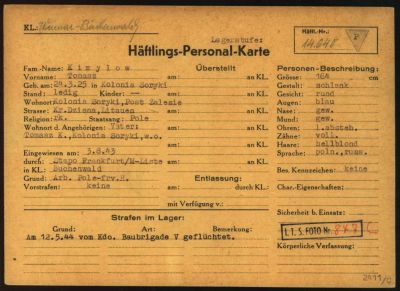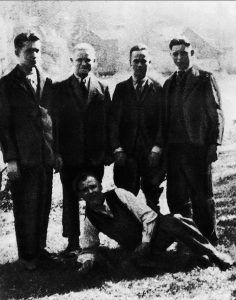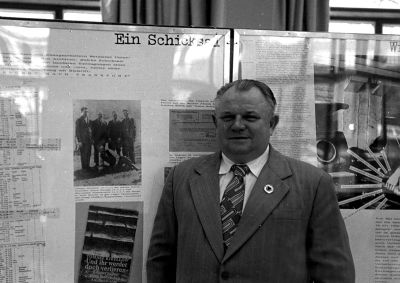Forced child labour in Hessen – The Story of Tomasz Kiryłłow

Even Polish children and young people were forced to work in the German Reich during the Second World War.[1] The specific case of a young man of Polish extraction has been remembered in Hessen since the 1980s. He had to work as a forced labourer in Wetzlar and was sent to what was then the “labour education camp” in Heddernheim (a district of Frankfurt am Main). His name was Tomasz Kiryłłow. The Wetzlar erinnert e.V. Association organised this commemorative work, with memorials and commemorative plaques erected in both Wetzlar[2] and Heddernheim[3], where the former “labour education camp” has become a memorial site. Even before the fall of the Berlin Wall, Tomasz Kiryłłow had travelled to Hessen from Poland to attend memorial ceremonies[4] in March /April 1987 because his memoirs had been published in Poland in 1980 and translated into German in the GDR in 1985[5]. On 1 April 1987 in the old Werner von Siemens School, as a guest of IG Metall [6], he recounted his experiences in Wetzlar (today Lahn-Dill district). Since the beginning of the 2000s, new publications[7] about the history of forced labour in Wetzlar have been published and since 2016 there has been a commemorative plaque[8] in the administrative centre of Lahn-Dill district, which remembers the forced labour in Wetzlar. Today, Wetzlar city council still keeps the memory[9] of the forced labour alive although it is not always clearly shown that Poles were also among the Russian, Belarussian and Ukrainian forced labourers.
Tomasz Kiryłłow, born on 24 March 1925 in Soryki (today Belarus), was part of this generation[10] of forced labourers. He was one of around 1.5 million children[11], who were forcibly removed from Poland and the Soviet Union[12] and taken to Germany as forced labourers during the Second World War. They worked in all areas of industry (even in the armaments industry), in agriculture, forestry and the domestic economy, in trades and in housekeeping. They worked for private and public employers and also within the framework of the Todt organisation[13].
[1] Macardle, Dorothy: Children of Europa. A Study of the children of liberated countries. Their war-time experience, their reactions, and their need, with a note on Germany, London 1949; Hrabar, Roman/ Tokarz, Zofia/ Wilczur, Jacek E.: Kinder im Krieg – Krieg gegen Kinder. Die Geschichte der polnischen Kinder 1939–1945, Reinbek bei Hamburg 1981; Mendel, Annekatrein: Zwangsarbeit im Kinderzimmer. ‘Ostarbeiterinnen’ in deutschen Familien von 1939 bis 1945. Gespräche mit Polinnen und Deutschen, Frankfurt a. M. 1994.
[2] Back in 1987, IG Metall initiated a memorial service in Wetzlar. In 2015, the Wetzlar erinnert e.V. Association designed a new exhibition about forced labour and created new information boards. https://wetzlar-erinnert.de/ns-zwangsarbeit/neue-ausstellung/tafel-1/ (last accessed on 27/06/2023).
[3] Krause-Schmitt, Ursula/ Freyberg, Jutta von (Publ.): Heimatgeschichtlicher Wegweiser zu den Stätten des Widerstandes und der Verfolgung 1933–1945. Volume 1/1: Hessen I. Regierungsbezirk Darmstadt, Frankfurt a. M. 1995, p. 127–131.
[4] In the 1980s, Tomasz Kiryłłow took part in a memorial ceremony in Heddernheim: cf. ibid, p. 129. In 2013, the City of Frankfurt redeveloped the former Heddernheim “work education camp”. New plaques were installed in 2018. https://lisa.gerda-henkel-stiftung.de/datensammlung_zum_arbeitserziehungslager_frankfurt_m._heddernheim?nav_id=4286 (last accessed on 27/06/2023).
[5] Kiryłłow, Tomasz: “Und ihr werdet doch verlieren”. Erinnerungen eines polnischen Antifaschisten [I tak przegracie wojnę], translated from Polish by Brümmer, Berlin 1985 [Warszawa 1980].
[6] https://wetzlar-erinnert.de/ns-zwangsarbeit/neue-ausstellung/tafel-5/ (last accessed on 27/06/2023).
[7] Pollemans, Piet J.: Als Zwangsarbeiter in Deutschland. Erinnerungen an die Jahre 1943-1945 in Rüsselsheim und Wetzlar, Rüsselsheim 2000. Porezag, Karsten: Zwangsarbeit in Wetzlar. Der “Ausländer-Einsatz” 1939–1945. Die Ausländerlager 1945–1949, Wetzlar 2002.
[8] https://wetzlar-erinnert.de/gedenken/gedenkorte/gedenktafelenthuellung-im-kreishaus/ (last accessed on 27/06/2023).
[9] https://www.wetzlar.de/rathaus/aktuelles/pressemitteilungen/archiv/2021/06_Juni/gedenken-an-zwangsarbeite.php?p=4021,3932,11407,4249,74465 (last accessed on 27/06/2023).
[10] In the historiography, various investigations are already available which use the tools of microhistory to focus on specific regions: e.g. Valentina Maria Stefanski on Leverkusen, Susanne Kraatz on Heidelberg, Margarethe Ruff on Vorarlberg, Thomas Muggenthaler on Bavaria, Margot Löhr, Herbert Diercks on Hamburg. Galina Knat’ko has also reseached the forced labour of Belarusian children in Austria. The research analyses different groups of youths from Poland and the Soviet Union (and from Ukraine). cf. Stefanski, Valentina-Maria: Zwangsarbeit in Leverkusen. Polnische Jugendliche im I.G. Farbenwerk, Osnabrück 2000; Kraatz, Susanne (Publ.): Verschleppt und vergessen. Schicksale jugendlicher “OstarbeiterInnen” von der Krim im Zweiten Weltkrieg und danach. Book accompanying the exhibition in Heidelberg town hall, Heidelberg 1995; Ruff, Margarethe: Minderjährige Gefangene des Faschismus. Lebensgeschichten polnischer und ukrainischer Zwangsarbeiterinnen und Zwangsarbeiter in Vorarlberg, Innsbruck/Vienna 2014; Muggenthaler, Thomas: “Wir hatten keine Jugend”. Zwangsarbeiter erinnern sich an ihre Zeit in Bayern, Viechtach 2003; Löhr, Margot: Die vergessenen Kinder von Zwangsarbeiterinnen in Hamburg. Ermordet durch Vernachlässigung und Unterernährung. Two volumes, Hamburg 2020; Diercks, Herbert (Publ.): Verschleppt nach Deutschland! Jugendliche Häftlinge des KZ Neuengamme aus der Sowjetunion erinnern sich, Bremen 2000; Knat’ko, Galina: Die Verschleppung weißrussischer “Ostarbeiter” zur Zwangsarbeit ins Deutsche Reich (1941-1944), in: Ludwig Boltzmann Institut für Kriegsfolgen-Forschung inter alia. (Publ.): “Ostarbeiter”. Weißrussische Zwangsarbeiter in Österreich. Dokumente und Materialien, Graz/Minsk 2003, p. 6–25.
[11] Steinert, Johannes-Dieter: Deportation und Zwangsarbeit. Polnische und sowjetische Kinder im nationalsozialistischen Deutschland und im besetzten Osteuropa 1939–1945, Essen 2013.
[12] Ibid, p. 11. Cf. Pohl, Dieter/ Sebta, Tanja (Publ.), Zwangsarbeit in Hitlers Europa. Besatzung – Arbeit – Folgen, Berlin 2013.
[13] This building unit of the Nazi state used forced labourers, prisoners of war and concentration camp prisoners for construction projects in the occupied territories during the Second World War.




